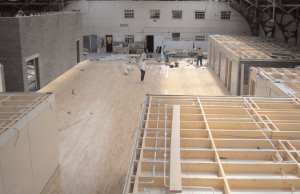
Thousands of artists around Britain are struggling to produce work in difficult conditions. Matthew Rooke looks at what constitutes a decent workspace for an artist.
If you are an arts professional working in a public body or a well-funded arts organisation, there is probably a long list of challenges lurking in your inbox. However, these are unlikely to include knowing where you are going to work from today; whether you can personally afford your workplace; whether it will have the basic kit to enable you to do your job; whether you will have heat and light; whether it is compliant with health and safety legislation; whether& well, I could go on and on. In short, it is most likely that all you had to do when you came to work was open the door, sit down and then focus all of your energies on making art happen.
For many artists (particularly those at the beginning of their careers) the situation is very different. Throughout the UK, demand for workspace generally exceeds supply and much of the space that is available often scores poorly in a number of critical areas. Over the past eight years, Scottish Cultural Enterprise (SCE) has worked on a wide range of projects on behalf of public bodies, private developers, large-scale arts organisations and individual artists, acquiring and developing workspace. The following is a distillation of some of the key things that we have learned.
Basic needs
Whilst many artists reach for the moon in their art, their requirements for workspace are very modest. At the most basic level most artists would be happy with workspace that is:
- Big enough to work in with ease
- Safe and secure
- Accessible 24 hours a day
- Close to good public transport
- Reasonably priced
- Warm and dry
- Well lit
- Equipped with broadband/phone
- Basically clean (i.e. properly functioning loos, no vermin, etc.)
There are, of course, other things that certain artists will want, but the above should form the fundamental elements for any artists workspace. At its most basic, this sort of provision could, with perhaps some compromises, be achieved within the space afforded by a garage (which can, for example, be rented from housing associations/local authorities) or a garden shed-kit that can be bought for around £2,000. Many artists workspace requirements can be met for modest sums, if only there is a mechanism in place to handle such needs.
But achieving mere subsistence should not be the limit of an artists expectations. Over and above these basic needs, many artists have other expectations, which SCE calls workspace+. In addition to basic workspace they would like to have some or all of the following:
- Space to showcase their work (a flexible gallery/performance space)
- Space to run education workshops (could be the same as the above)
- Dirty workshop space (for larger, light industrial-type construction)
- Administration support and facilities (in terms of people and equipment)
- Building-management facilities (it is one thing for Duchamp to present a urinal as a piece of art, another to maintain one on a day-to-day basis)
- Informal social space (to break out, take a coffee and chat)
- Resource base (information on funding, work opportunities, etc.)
The typical response of the powers-that-be to these challenges has been to create large communal artists workspaces, and a number of excellent examples of these models exist throughout the UK such as WASPs in Scotland, Chapter Arts in Wales, Waygood and Lime Street Studios in the North East, the Custard Factory in the West Midlands, and ACME in London, to cite but a few.
However, as soon as one moves to the workspace+ model, the costs begin to mount up. A much larger scale of building is required and such spaces require specialist, dedicated management (workspace longevity often depends upon one or more artist/collective members putting down their brushes and taking up the reins of management) and this costs money. It also demands a more formalised structure: someone has to mediate potentially clashing interests or personalities; health and safety legislation has to be observed (which means that rules have to be created and, crucially, policed); and someone has to extract money from both the tenants and funding bodies.
Merging practice
There is also an issue about the fit of different forms of practice. Even within the visual arts there is a range of needs, with those of digital artists being very different from the quasi-light industrial needs of a sculptor, for instance. Similarly, accommodating a rock band rehearsal space next door to a writers thinking place demands particular construction techniques that have cost implications. One has to be very specific, therefore, about the types of use envisaged in a scheme if it is to hang together, in terms of cost, ethos and operation
However, all of the above presupposes that one has space (or access to a site) to begin with. At present, property is not just a tool for business; it is also seen as a refuge for wealth in the face of market uncertainty. The net result is that demand for property in the mainstream market place is considerable.
For anything other than a small niche development (say, a single or double workspace unit in a problematic part of town) suitable properties offered in the mainstream property market are beyond the financial reach of virtually all artists. Given that funders are often reluctant , or unable, to subsidise such purchases, artists are primarily limited to what are termed sub-prime properties. These can be disused buildings, historic buildings that are uneconomic to restore without subsidy, or simply poor buildings in the wrong part of town.
Partnerships
Some commercial property owners either offer property on medium-term leases (reducing overheads whilst development plans come to fruition), or are big enough to be able to put something back into the community (such as major plcs foregoing the full market value of their assets).
Local authorities also own land and/or buildings that are surplus to requirements, and in most local authority areas there will be someone in the economic development/ regeneration departments who will have a list of such properties. The planning department will also have someone who is responsible for heritage buildings at risk, although large-scale public funding will almost certainly be required to convert or develop such sites (and, perhaps, to operate them). The process of securing funding, undertaking feasibility and design studies and then implementing them often takes three to four years from start to finish. In effect, therefore, any artist-led initiative could see an artist giving up three to four years of creative life to deliver a scheme.
Very often, larger-scale artists workspace units are provided as part of a regeneration project. In these circumstances the case for support for artists is made on the basis of their unique role in stimulating community development, transforming the feel of an area, bringing new economy creative industries enterprise to rundown old economy areas and aiding gentrification (and hence increasing property values).
This approach has delivered a number of valuable assets for artists, but there are downsides. First, there is a level of expectation placed upon artists that might not be consistent with their own vision some people do not want to be instruments of social policy or pioneers for commercial developers. Second, there is a point at which one generation of artists so successfully transforms an area that the next generation cannot afford to get in, and so the cycle of exclusion starts again.
There are a number of heartening examples of bodies such as the Arts Council showing real initiative and innovation in this area, but you do not have to be part of a big national body to help make things happen. There are a number of simple ways that people involved in arts development can make things easier for artists.
Working together
Talking to artists and establishing their needs in arts development can make a difference. You may be surprised at just how isolated people with potentially common interests can be. By initiating contact with the relevant people in public bodies to identify surplus/ vacant land/buildings, more often than not a scheme will be unearthed that is looking for an end user to kick-start the development process.
Similar engagement with the private sector can yield sub-prime commercial property or developments that could embrace the arts sector as part of offering planning gain. Again, funding providers can provide a better understanding of access to finance initiatives in local areas.
At a strategic level you might wish to stimulate debate in your own organisation about taking a fresh approach to capital projects. Not every publicly funded building, for example, has to be a landmark piece of architecture a shed might suffice. Short-term, limited life structures also might be preferable to conventional-build schemes. By helping interested parties to get together to discuss these matters, funders and agencies can help to change the national landscape of workspaces.
For those just setting out on a career as an artist, possibly saddled with student debt and unable to get on the property ladder, getting a workspace can transform their lives. Arts managers are often party to a wealth of information and contacts that can, with a little preparation and perhaps outside help, be drawn together to help the next generation of artists secure their own little piece of heaven on earth.

Matthew Rooke is Director of Scottish Cultural Enterprise.
t: 0141 248 5862;
w: http://www.scottishculture.co.uk



